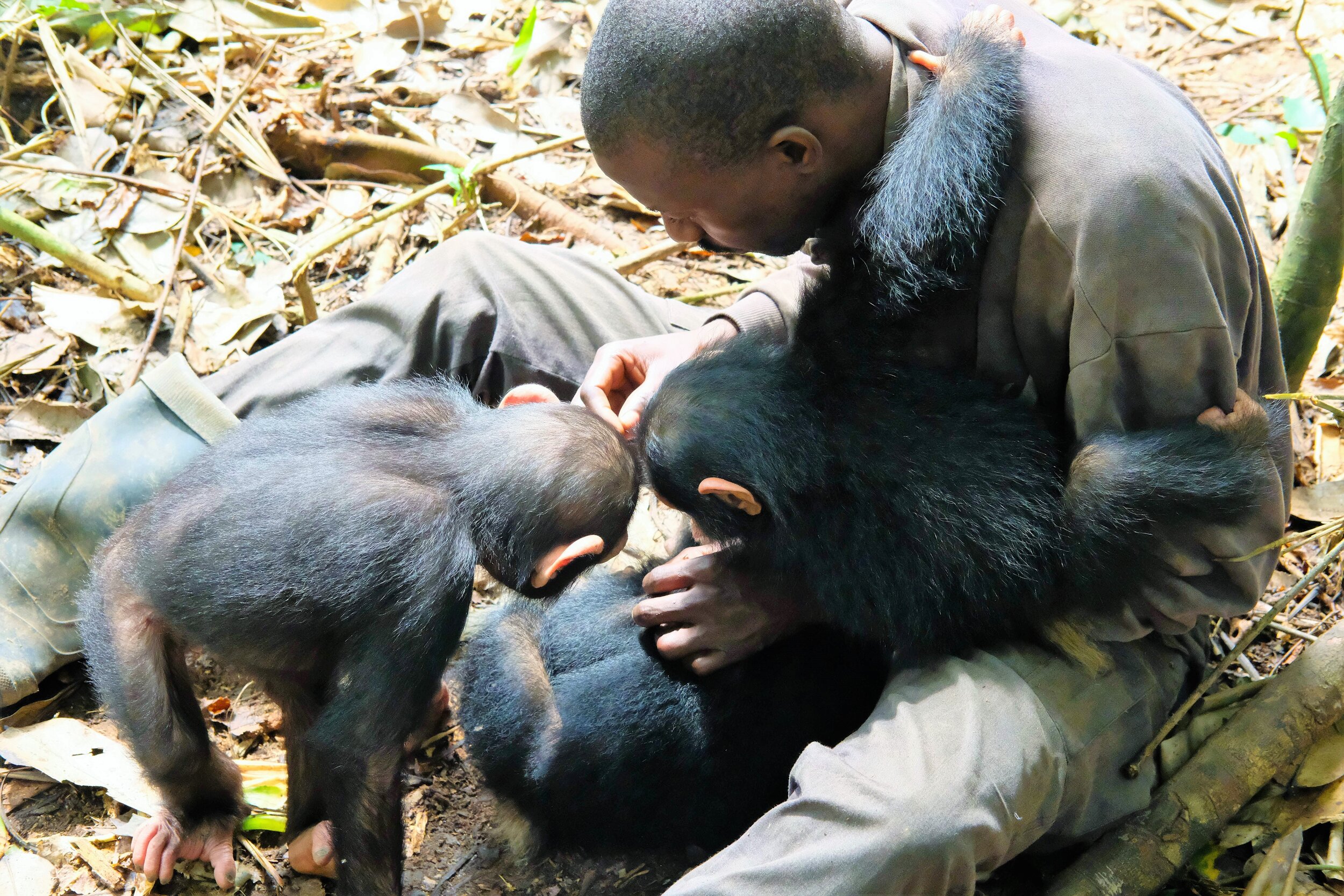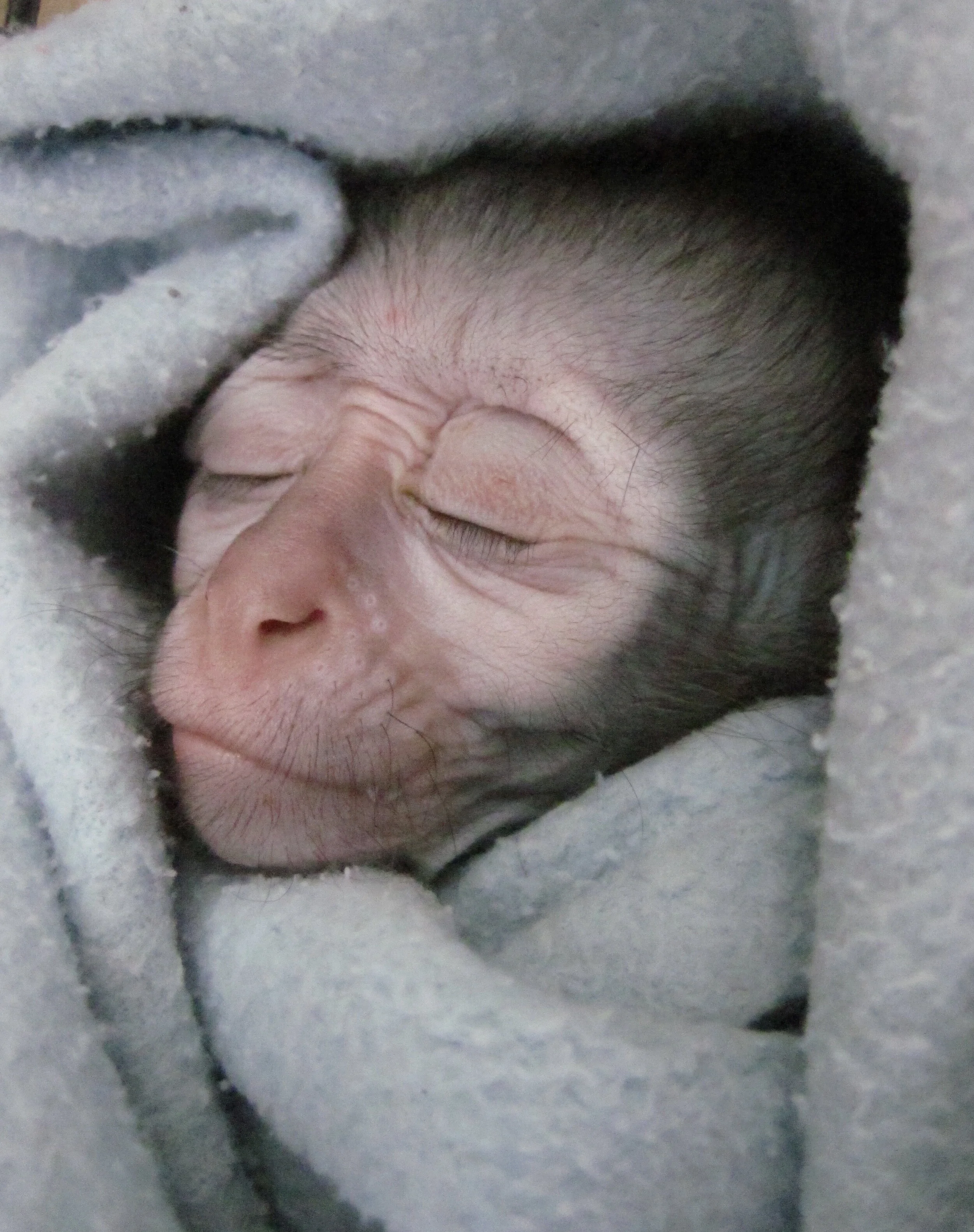A Touchy Subject in Primate Caregiving
By Robin Huffman, Safina Center Fellow
Recently, hearing of my primate-focused volunteering work in Africa, two women approached me, eager to share that they’d visited a primate sanctuary and played with orphaned infant chimpanzees. After my four-plus years of caregiving for over a dozen species of orphaned monkeys and several apes at African sanctuaries, alongside caregiving staff, their story troubled me. I wrote to them afterwards describing why, based on what I’ve learned, visitors handling exotic animals was problematic. I share some of those now. Protocols vary by sanctuary, but you’ll get a sense of why their experience bothered me.
Firstly, all primates are wild animals. They should have remained in the wild, but because of humans they ended up at a sanctuary. Many are traumatized, both physically and psychologically. How these orphaned monkeys and apes are handled by humans when they arrive is crucial to their recovery and their chance at success with their own kind.
Chickaboo, Lucy, Afangui, orphaned female juvenile gorillas at Ape Action Africa. Photo: Robin Huffman
How a young gorilla is handled upon landing at a sanctuary can mean life or death. They’re so sensitive that an infant gorilla can actually die from grief, after seeing its mother and family slaughtered and being mistreated by its captors. Therefore, individuals who care for young gorillas are specialists—exceptional in many ways. Chimp infants are heartier but may have suffered immensely as well and can be depressed and distrustful. Due to early trauma, exceptional care, from trained caregivers, is imperative.
Caregivers ideally learn to mimic behaviors and sounds of their charges’ species, particularly things their mothers might do, like grooming, reassuring, encouraging exploration, safeguarding and even scolding.
Caregiver Sanda grooming infant chimp Noah while Ndongo and Sandie look on, at Ape Action Africa. Photo: Amy Hanes
Caregivers typically don’t sleep with their charges (though there are exceptions). Sleeping with infants can increase attachment and become traumatic and an impediment for the infant when it’s time to transfer their affections to nonhuman primates. However, caregivers do stay close while infants fall asleep. We often swaddle baby monkeys for added comfort and stress-free transfer to their bed.
Swaddled infant vervet monkey Keksie at Vervet Monkey Foundation. Photo: Robin Huffman
Although human caregivers are a poor substitute, they must do their best. Orphans need to be equipped, physically and socially, for assimilating with their tribe. And human touch, particularly when lacking sensitivity to the species’ protocols, can be harmful, even life- threatening, as anthropologist Amy Hanes elaborates.
Noah riding his caregiver Sanda's back at Ape Action Africa, award-winning photo by Amy Hanes
So, for many reasons, reputable sanctuaries typically don’t allow visitors to touch the wild creatures in their care. Some reasons include:
Zoonotic diseases transmit both ways. For example, common colds travel like wildfire through young chimp groups.
Wild animals, even small or seemingly sweet ones, can be dangerous and inflict great harm in an instant.
Most have suffered traumatic events. They need and deserve privacy.
Orphans too accustomed to unnatural human interaction may be unable to ever live with their own kind again.
Visitors who are allowed to touch wild animals at a sanctuary get the impression it’s normal. It’s not. They are wild, not domesticated. It’s stressful and intrusive to the animal, and takes advantage of their accessibility and vulnerability.
Some argue it helps inspire individuals to want to protect endangered species. If someone truly loves and wants to conserve a wild species, it shouldn’t have to rely on petting or having an unnatural photo-op with a wild animal, which is also wholly harmful to the animal.
It’s a great privilege and responsibility to be a young-primate caregiver, helping the orphans grow healthy, social, confident, and independent so they can live and thrive among their own species. They are not pets, playthings, entertainment, or photo-ops, nor are they there to satisfy humans’ craving to pamper human-like babies. They are evolved individuals of distinct character who deserve respect by those temporary guardians who serve them.
Bitsy, agile mangabey monkey, and Junior, grey-cheeked mangabey drinking milk at Ape Action Africa. Photo: Robin Huffman
If offered the chance to casually handle a wild animal, please consider the price they pay.





